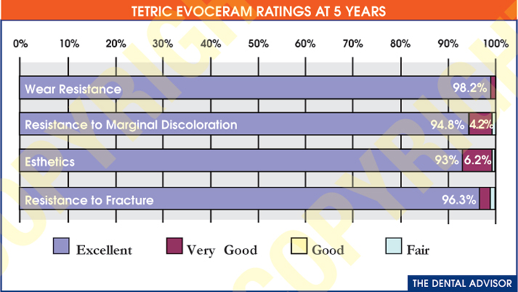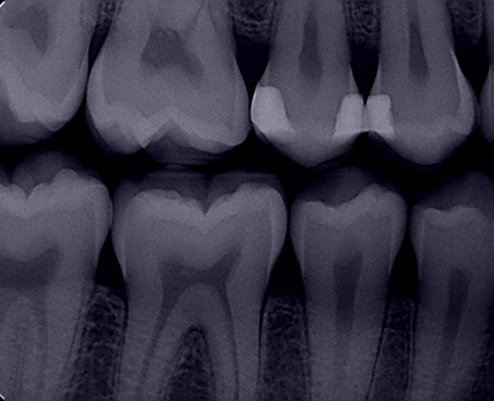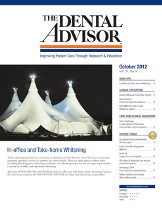Clinical Evaluations
Tetric EvoCeram (5 yr)
Consultants’ Comments
- “Material handles and sculpts well.”
- “Great chameleon effect!”
- “A good universal product for all-around use.”
- “Retains esthetics and polish well over time.”
- “Nice, distinct radiopacity.”
Description
Tetric EvoCeram is a universal, nano-hybrid composite indicated for anterior and posterior restorations. Twenty-two radiopaque shades are available: B1, A1, A2, A3, A3.5, A4, B2, B3, C1, C2, C3, D2, D3 (enamel); A3.5, A4, B2 and A2 (dentin); T (transparent incisal); XL, L, I, M (bleach). This light-cured composite consists of particles ranging in size from 40 to 3,000 nm with an average particle size of 550 nm. It is packaged in 0.2 g, color-coded, unit-dose capsules and 3 g, color-coded syringes.
Clinical Evaluation Protocol
- Over 800 Tetric EvoCeram restorations were placed and monitored over a five-year period.
- Six hundred fifteen of these restorations were evaluated at patient recall. The restorations represented one to four surface composites of which 96% were posterior and 4% were anterior restorations.
- Sixty-three percent of the restorations evaluated were bonded with AdheSE, a 6th-generation bonding agent, while the rest were bonded with a variety of other bonding agents.
- At recall the following categories were assessed on a scale of 1-5
(1 = poor, 2 = fair, 3 = good, 4 = very good, 5 = excellent).
Clinical Observations
Lack of Fracture/Chipping
Over 96% of the restorations evaluated received an excellent rating (Figure 1). Twenty-three (3.7%) of the 615 restorations evaluated had chipped or fractured at recall. Ten (1.6 %) of the 23 restorations needed to be replaced because the fracture could not be repaired. Tetric EvoCeram proved to be very resistant to fracture and chipping at five years, especially since 96% of the restorations evaluated were posterior restorations.
Esthetics
The esthetics of Tetric EvoCeram was excellent at recall (Figure 1). Out of 615 restorations evaluated, 572 (93%) received a 5 (excellent) rating. Thirty-eight restorations (6.2%) received a 4 rating and only five (0.8%) restorations received a poor rating. These were all anterior restorations and belonged to one patient who was a smoker. All other restorations blended extremely well with the tooth. When any shade was layered with the translucent shade, the opalescence and translucency improved the esthetics even further. In cases where the tooth was not discolored and the preparation was shallow, using the translucent shade alone was sufficient to result in a restoration that was undetectable. An example of the radiopacity of Tetric EvoCeram is shown in Figure 2.
Resistance to Marginal Discoloration
Nearly 95% of the restorations evaluated received an excellent rating (Figure 1). Thirty-two out of 615 restorations (5.2%) exhibited some marginal staining and received a rating of 4. Six restorations (1%) needed to be replaced due to staining and discoloration. The majority of these were anterior restorations. The staining at the margin was not related to any particular bonding agent.
Wear Resistance
Over 98% of the restorations evaluated received an excellent rating (Figure 1). Only eleven (1.8%) of the restorations exhibited some wear and received a rating of 3. Over 600 of the recalled restorations exhibited no visible wear.
Surface Finish
Not only did the restorations blend well with the surrounding tooth, but also the surface finish was excellent at recall. The restorations routinely had a glossy and smooth appearance.
Figure 1. Ratings of Tetric EvoCeram at five years.
Conclusions
Tetric EvoCeram is a composite with excellent handling characteristics. It is packable, not sticky, contours well, and is easy to finish and polish with excellent results. The results of the five-year evaluation of 615 restorations demonstrated that the composite had superior performance in all areas, including lack of fracture and chipping, esthetics, lack of microleakage, and surface finish. Tetric EvoCeram received a 97% clinical rating at the five-year recall.

Figure 2. Radiograph of #4 and #5 showing the distinct radiopacity of Tetric EvoCeram.


